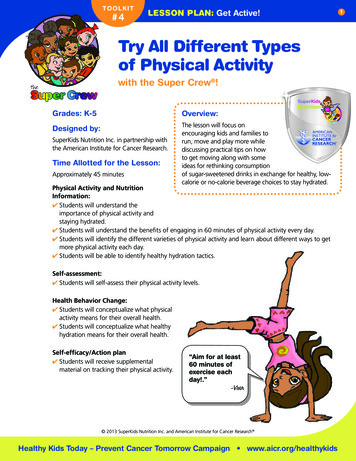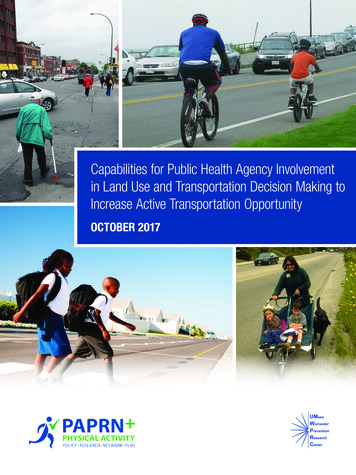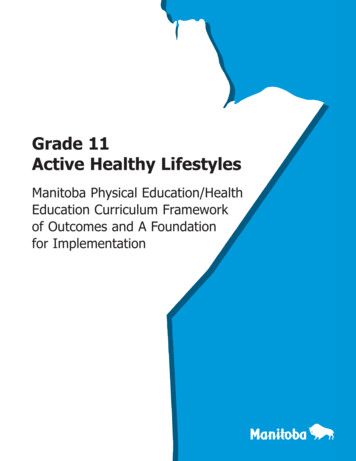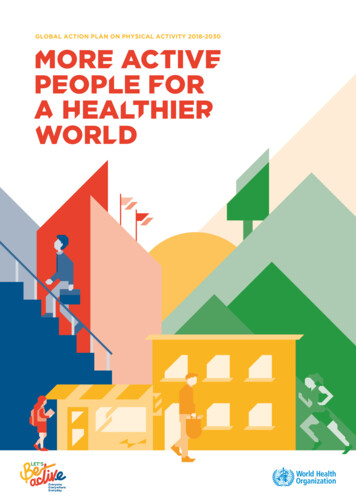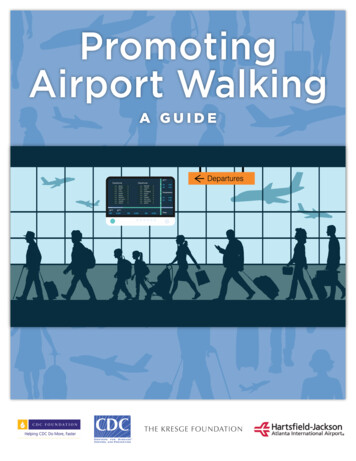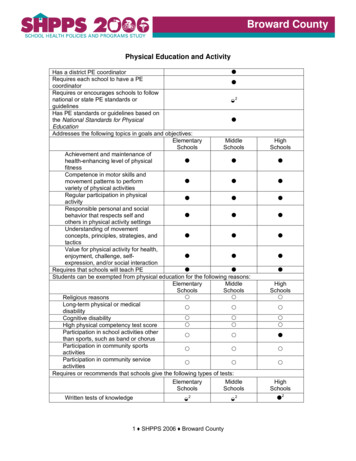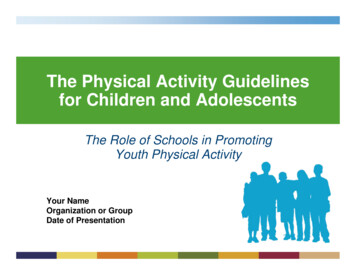
Transcription
The Physical Activity Guidelinesfor Children and AdolescentsThe Role of Schools in PromotingYouth Physical ActivityYour NameOrganization or GroupDate of Presentation
Presentation Objectives Identify the benefits ofregular physical activityamong youthDescribe the key physicalactivity guidelines forchildren and adolescentsDescribe the role ofschools, in partnership withfamilies and communities,in promoting physicalactivity among children andadolescents
A Day in the Life of Colin:A 7-Year-Old Child Walks to and from schoolJumps rope and doesgymnastics in physicaleducation classPlays on the playgroundduring recessDoes homeworkWatches televisionPlays soccer with familyPlays video games
What Are the Benefits ofPhysical Activity? Promotes health and fitnessBuilds healthy bones and muscles1Reduces the risk of developingobesity and risk factors for diseasessuch as type 2 diabetes and heartdisease1Reduces the symptoms of anxiety anddepression1Can positively affect concentration,memory, and classroom behavior21. HHS. Physical Activity Guidelines Advisory Committee Report;20082. J Pediatr 2005;146(6):732–7.
How Much Physical ActivityDo Youth Need? Children and adolescents should do 60 minutes (1 hour) ormore of physical activity daily. Aerobic Activities: Most of the 60 or more minutes per dayshould be either moderate- or vigorous-intensity aerobic physicalactivity. Include vigorous-intensity physical activity at least 3days per week. Muscle-strengthening Activities: Include muscle-strengtheningphysical activity on at least 3 days of the week, as part of the 60or more minutes. Bone-strengthening Activities: Include bone-strengtheningphysical activity on at least 3 days of the week, as part of the 60or more minutes.Activities should be age-appropriate, enjoyable, and offer variety.
What Does This Really Mean? At least 60 minutes every dayMostly aerobic activitiesAdd variety and fun
What are Aerobic Activities? Activities that keep yourbody moving enough toincrease your heart rateand make you breatheharderThere are two intensitiesof aerobic activity: Moderate-intensity Vigorous-intensity
Judging the Intensity of AerobicActivities Moderate-intensity Activity Heart will beat faster thannormal and breathing will beharder than normal On a scale of 0 to 10, moderateintensity activity is a 5 or 6 Vigorous-intensity Activity Heart will beat much faster thannormal and breathing will bemuch harder than normal On a scale of 0 to 10, avigorous-intensity activity is7 or 8
Types of Moderate- and VigorousIntensity Aerobic ActivitiesType ofPhysicalActivityModerateintensityaerobicAge GroupChildren Active recreation, such as hiking,skateboarding, rollerbladingBicycle ridingBrisk walkingAdolescents Vigorousintensityaerobic Active games involving running andchasing, such as tagBicycle ridingJumping ropeMartial arts, such as karateRunningSports such as soccer, ice or fieldhockey, basketball, swimming, tennisCross-country skiing Active recreation, such as canoeing,hiking, skateboarding, rollerbladingBrisk walkingBicycle riding (stationary or road bike)Housework and yard work, such assweeping or pushing a lawn mowerGames that require catching andthrowing, such as baseball and softballActive games involving running andchasing, such as flag footballBicycle ridingJumping ropeMartial arts, such as karateRunningSports such as soccer, ice or fieldhockey, basketball, swimming, tennisVigorous dancing, cross-country skiing
What are Muscle-StrengtheningActivities? Activities that make muscles domore work than usual activitiesof daily lifeActivities that can be part ofunstructured play Climbing trees Playing tug-of-warActivities that can be structured Push-ups, pull-ups Working with resistancebands Lifting weights
Types of Muscle-StrengtheningActivitiesAge GroupType of Physical ActivityChildrenMuscle-strengtheningAdolescents Games such as tug-ofwar Games such astug-of-war Modified push-ups (withknees on the floor) Push-ups and pull-ups Climbing wall Resistance exercisesusing body weight orresistance bands Rope or tree climbing Swinging on playgroundequipment/barsSit-ups (curl-ups orcrunches)Resistance exerciseswith exercise bands,weight machines, handheld weightsSit-ups (curl-ups orcrunches)
What Are Bone-StrengtheningActivities? Activities that produce aforce on the bones thatpromotes bone growth andstrength, such as jumping Activities that areespecially important foryoung people because thegreatest gain in bone massoccur during the years justbefore and during puberty
Types of Bone-strengthening ActivitiesAge GroupType ofPhysical ActivityBone-strengtheningChildrenAdolescents Games such ashopscotch Hopping, skipping,jumping Hopping, skipping,jumping Jumping rope Jumping ropeRunningSports such asgymnastics, basketball,volleyball, tennisRunningSports such asgymnastics, basketball,volleyball, tennis
How Are the Guidelines for YouthDifferent from the Guidelines for Adults? Take into consideration naturalactivity patterns of children All episodes of moderateor vigorous-intensityactivities count toward dailyrequirement Unstructured active playcan provide all three typesof physical activityDaily physical activity requiredSpecify need for bonestrengthening activities andvigorous-intensity activitieseach week
Meeting the GuidelinesGetting and Staying Active
How Physically Active Are High 4.9BlackHispanic10.50TotalFemaleMaleWhite* Were physically active doing any kind of physical activity that increased their heart rate and made them breathe hardsome of the time for a total of at least 60 minutes/day during the 7 days before the survey.Source: National Youth Risk Behavior Survey, 2007.
How Much Do 9- to 13- Year-OldsParticipate in Physical Activity?OrganizedActivityFree-TimeActivityBlack, non-Hispanic24%75%Hispanic26%75%White, non-Hispanic47%79%Total39%77%Race/EthnicitySource: MMWR 2003;52(33):785–8.
Meeting the Guidelines Youth Who Don’t Meet the Guidelines Participate in enjoyable activitiesYouth Who Meet the Guidelines Slowly increase activity in small stepsContinue being active on a daily basisWork toward becoming more activeYouth Who Exceed the Guidelines Maintain activity levelVary the kinds of activities to reduce the risk of injury
A Day in the Life of Colin Walks to and from school (20 minutes)Jumps rope and does gymnastics in physicaleducation class (10 minutes each).Plays on the playground during recess (10minutes)Does homework (20 minutes)Watches television (30 minutes)Plays soccer with family (20 minutes)Plays video games (30 minutes)Total physical activity time 60 minutes Vigorous-intensity aerobic activity: jumpingrope Bone-strengthening activities: jumping rope,gymnastics Muscle-strengthening activities: gymnastics
Colin’s Weekly Physical ActivitiesMondayTuesdayWednesdayWalks to and from school20 minutesPlays on playground10 minutesJumps rope10 minutesDoes gymnastics10 minutesPlays soccer with family20 minutesWalks to and from school20 minutesPlays on playground25 minutesClimbs on playground equipment15 minutesWalks to and from school20 minutesPlays actively with friends25 minutesJumps rope10 minutesRuns5 minutesDoes sit ups2 minutes
Colin’s Weekly Activities, cont.ThursdayFridaySaturdaySundayPlays actively with family30 minutesPlays soccer30 minutesWalks to and from school20 minutesPlays actively with friends25 minutesBicycles15 minutesPlays on playground30 minutesClimbs on playground equipment15 minutesBicycles15 minutesPlays on playground10 minutesPlays soccer40 minutesPlays tag with family10 minutes
Maria: A 16-Year-Old Adolescent Maria participates in many types ofphysical activities in many placesShe plays tennis and does sit-upsand push-ups during physicaleducation classShe likes to play basketball at theYMCA, do yoga, and go dancing withher friendsShe likes to walk and hike with her dog
A Day in the Life of Maria Walks dog (10 minutes)Plays tennis (30 minutes)Does sit-ups and push-ups (5 minutes)Plays with children at the park whilebabysitting (15 minutes)Total physical activity time 60 minutes Vigorous-intensity aerobic activity: tennis Bone-strengthening activity: tennis Muscle-strengthening activity:sit-ups and push-ups
Barriers to Meeting the Guidelines Personal Attitude Belief in ability to bephysically activeSocial Influence of their peers Parental supportEnvironmental Safe locations to be active Access to equipment Financial costs of physicalactivities Time
Youth Physical ActivityThe Role of Schools
Why is Physical Activity Important ForSchools? Associated with lowerlevels of stress andanxiety1Can positively affectconcentration, memory,and classroom behavioramong adolescents2Can improve standardizedtest scores31. HHS. Physical Activity Guidelines Advisory Committee Report;2008.2. J Pediatr 2005;146(6)719–20.3. Res Q Exerc Sport 1999;70(2):127–34.
Physical Education and AcademicAchievement1 Nationally representative sample: 5,316students starting kindergarten in 1998–1999,followed through 5th grade Physical education (PE) measure:Low (0–35 mins/week), Medium (36–69),High (70–300) Academic achievement measure:Mathematics and reading tests designedby experts Results: A small but significant benefit on bothmath and reading tests were observed for girlsin the high PE category compared with those inthe low PE category; findings not seen in boys1. Am J Pub Health 2008;98(4):72–7.
Comprehensive School-BasedPhysical Activity Program1 Components include: Quality physical education Daily recess period Activity breaks throughoutthe day Intramural sports Interscholastic sports Walk- and bike-to-schoolprograms Staff wellness and involvement Family and communityparticipation1. National Association for Sport and Physical Education. Comprehensive School Physical ActivityPrograms Package; 2008.
Physical Activity vs. Physical Education1 Physical activity behavior Physical education curriculararea that teaches aboutphysical activity Provides students with theskills needed to participatein a lifetime of physicalactivity1. National Association for Sport and Physical Education. Understanding TheDifference: Is It Physical Education or Physical Activity?;2005.
What is Quality Physical Education? Opportunity to learn Adequate time, equipment, and facilities Highly qualified, certified, or licensedteachersMeaningful content Written standards-based curriculum Sequential, developmentally appropriatelearning activities for grades K–12Appropriate instruction Full inclusion of all students Well-designed lessons that facilitatelearning Sufficient practice opportunities for classactivities Student assessment
Other Characteristics of QualityPhysical Education Programs Enjoyable experience for all studentsMeet the needs and interests of all studentsKeep students active for most of class time More than 50% of class time spent in moderate- tovigorous-intensity activityPolicy Recommendation: Schools should require dailyPE for students in kindergarten through grade 121 Elementary school 150 minutes per weekSecondary school 225 minutes per week1. National Association for Sports and Physical Education. Moving into the Future: National Standards forPhysical Education, 2nd ed;2004.
Recess Opportunity to participate in freetime physical activity and practiceskills learned in physical educationclasses Enhances cooperation andnegotiation skills Improves attentiveness,concentration, and time-on-task inthe classroomPolicy Recommendation: Schools should provide at least 20minutes of recess per day, in addition to physical educationclasses11. National Association for Sport and Physical Education. Recess in Elementary Schools;2006.
Physical Activity Breaks Independent of physical education and recessCan enhance positive classroom behavior of studentsIncorporates activity in the classroom as part of plannedlessonsPhysical Activity Break Ideas: Ask students to identifyand act out action words from a story through physicalactivity or take a walk outside as part of a science class
Intramural Sports Can be offered before, during,and after school Provide students with a choicein activities Offer every student an equalopportunity to participateregardless of ability level Incorporate lifetime physicalactivities such as walking,running, hiking, swimming,tennis, dancing, and bicycling
Interscholastic Sports 1.2.3.4.Help establish cooperative andcompetitive skills1Help students learn sport-specificand performance-based skillsMay be related to higher levels ofoverall physical activity2Associated with improved mentalhealth and reduction in some riskyhealth behaviors3–4National Association for Sports and Physical Education. Eight Domains of Coaching Competencies;2006.Pediatr Exerc Sci 1998;10:378–86.Arch Pediatr Adolesc Med 2000;154:904–11.The President's Council on Physical Fitness and Sports. Research Digest 1997;2:1–12.
Benefits of Active Commuting toSchool Increases physical activitylevels1–3Reduces the number of carsand decreases traffic nearschoolsPromotes partnerships amongstudents, parents andcommunity organizations andmembers1. Am J Prev Med 2005;29(3):179–84.2. BMJ 2005;331(7524)1061–2.3. Med Sci Sports Exerc 2005;37(12):2062–9.
Prevalence of Active Commutingto or from School908070605040302010019692001walk/bike anydistancewalk/bike 1mileSource: Am J Prev Med 2007;32(6):509–16.walk/bike 2miles
Walk and Bicycle to School ProgramsActivity Recommendation:Schools should participate inInternational Walk to School Weekand support ongoing walk and biketo school programs Resources: Safe Routes to Schools Walking School Bus KidsWalk Guide
Working Together:Joint Use Agreements Share resources: athletic fields,playgrounds and fitness facilitieswith other community membersand organizations. Open school facilities to providephysical activity programs tostudents, families, school staff,and community members. Seek funding from localbusinesses, community groupsand health organizations forphysical activity programsand events
Working Together:Community Involvement In School-BasedPhysical Activity Support school-basedphysical activity Join the school healthadvisory council Donate equipment, moneyor encourage staff tovolunteer time Support Safe Routes toSchool programs Offer after-school physicalactivity programs
Thank you!Questions?Be Active and Play, 60 minutes, every day!Information in this presentation is provided byU.S. Department of Health and Human ServicesCenters for Disease Control and PreventionNational Center for Chronic Disease Prevention and Health PromotionDivision of Adolescent and School Healthwww.cdc.gov/HealthyYouth
Modified push-ups (with knees on the floor) Resistance exercises using body weight or resistance bands Rope or tree climbing Sit-ups (curl-ups or crunches) Swinging on playground equipment/bars Games such as tug-of-war Push-ups and pull-ups Resistance exercises with exercise bands, weight machines, hand-held weights .



